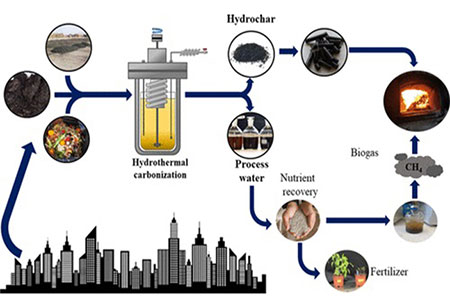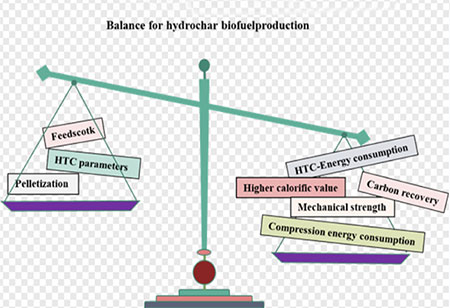
The Hydrothermal Carbonization (HTC) method stands as a pioneering tech- nology poised to revolutionize the waste-to-energy sector. It has garnered widespread attention as a preferred option for individuals and organizations committed to sustainable energy solutions and efficient waste management practices. By employing HTC, noxious organic substances can be converted into valuable materials, potentially serving as energy carriers, aligning seamlessly with the principles of the circular economy. In the course of this transformative process, biomass undergoes a metamorphosis into hydro- char, a high-carbon substance.
This innovative and environmentally conscious approach not only addresses the escalating challenge of waste accumulation but also plays a pivotal role in generating valuable byproducts and fostering the production of renewable energy. A report by 360 Market Updates anticipates that the global hydrothermal carbonisation (HTC) market is poised to grow at a CAGR of 10.5 percent from 2023 to 2029, from $874 million in 2022 to $1685.7 million in 2029. The influencing factors driving significant market fluctuations include events such as the Russia-Ukraine War, the impact of COVID-19, and prevailing economic conditions.
Understanding Hydrothermal Carbonization
Hydrothermal Carbonization (HTC) involves subjecting biomass or organic waste to high temperatures and pressure within water, typically ranging between 180 to 250 degrees Celsius. This method accelerates a natural process that would otherwise occur over millennia into a matter of hours. The resulting product of this rapid treatment is hydrochar, a dense material rich in energy content. Hydrochar finds versatile applications, including energy generation, soil enhancement, and carbon sequestration, thus exemplifying its multifaceted utility in sustainable resource management.
Advantages of HTC in Waste to Energy
Efficient Biomass Conversion: Hydrothermal Carbonization (HTC) effectively utilizes a variety of biomass feedstocks, including organic municipal waste, sewage sludge, and agricultural residues, to produce hydrochar. Its adaptability makes it a preferred choice for waste-to-energy applications.
Carbon Sequestration: The stable nature of hydrochar generated through HTC enables effective carbon storage over prolonged periods. This feature contributes significantly to the reduction of greenhouse gas emissions, thus bolstering efforts to combat climate change.
Energy Production:Hydrochar, often likened to "bio-coal" due to its analogous properties, serves as an excellent energy source. By substituting conventional fossil fuels with hydrochar (a solid fuel) in various industrial processes, reliance on non-renewable resources can be mitigated, facilitating sustainable energy production.
Nutrient-Rich By-products: The liquid by-products resulting from HTC, referred to as hydrothermal liquefaction (HTL) products, harbor valuable nutrients essential for plant growth. These by-products can be repurposed as fertilizers or soil amendments, embodying a circular approach that minimizes waste while maximizing the resource potential of organic materials.
Reduction in Greenhouse Gas Emissions: HTC plays a pivotal role in curbing methane emissions from landfills by converting organic waste into hydrochar. Additionally, by circumventing the combustion of biomass, which releases carbon dioxide, HTC contributes to a notable reduction in greenhouse gas emissions. This underscores HTC's status as a sustainable and environmentally friendly waste management solution.
"Waste to energy plays a role in achieving the transformation to a sustainable energy ecosystem by serving as an energy source to reduce greenhouse gas emissions, a clean demand response option, a design consideration for eco-industrial parks, and, in some cases, the only option for end-of-life waste treatment" - Denis Bauer, CEO, Cnim Martin
 Applications of Hydrothermal Carbonization
Applications of Hydrothermal Carbonization
Municipal Waste Management: The utilization of hydrothermal carbonization presents a promising solution for the ever-expanding challenge of municipal waste management. By converting organic waste into hydrochar, municipalities can significantly reduce landfill volumes, mitigate greenhouse gas emissions, and foster renewable energy production.
Improved Soil Health:Hydrochar produced via Hydrothermal Carbonization (HTC) serves as a potent soil amendment, enriching soil fertility, bolstering water retention capabilities, and promoting overall soil vitality. This application aligns with sustainable agricultural practices, supporting long-term soil health and productivity.
Valorization of Agricultural and Forestry Residues: Hydrothermal Carbonization (HTC) offers a sustainable pathway for transforming agricultural and forestry residues into valuable hydrochar. Incorporating hydrochar into soil enhances its fertility while concurrently mitigating the adverse environmental impacts associated with agricultural practices.
Wastewater Treatment: HTC emerges as a viable option for treating sewage sludge, converting it into hydrochar and mitigating the environmental impact of sludge disposal. The resultant hydrochar can serve as a soil amendment or be harnessed for energy generation, contributing to both soil health improvement and sustainable energy production.
Top of Form
Challenges & Future Outlook
While Hydrothermal Carbonisation (HTC) holds considerable promise for addressing diverse environmental and waste management challenges, numerous obstacles must be overcome to fully realize it’s potential. One of the biggest hurdles associated with HTC technology is its scalability, particularly when dealing with substantial volumes of organic waste. Additionally, the issue stemming from the varied composition of feedstocks necessitates tailored processing parameters for different biomass sources to yield hydrochar optimally. Ensuring consistent hydrochar quality and attributes across various feedstocks is imperative for widespread adoption. Moreover, the economic feasibility and market acceptance of hydrochar products are pivotal for the enduring viability of HTC. Substantial investment in research and development is also essential to reduce production costs, enhance product value, and explore novel applications.
Looking ahead, it is anticipated that developments in feedstock diversification, process optimisation, and market expansion would propel HTC's future prospects. It will involve cooperation between scientists, business leaders, and legislators to overcome obstacles and fully utilise hydrothermal carbonisation as a sustainable waste-to-resource solution. In the future, advancements in HTC technology may lead to improved integration with existing waste.
We use cookies to ensure you get the best experience on our website. Read more...